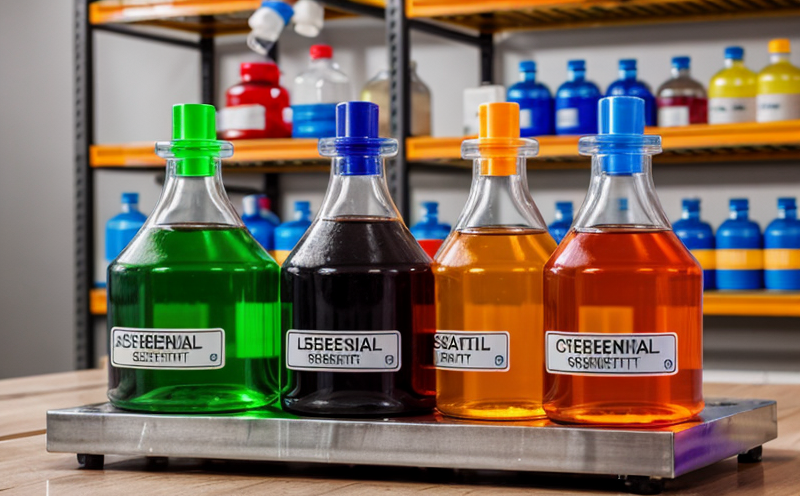Mutagenicity Testing of Restricted Substances
The mutagenicity testing of restricted substances is a critical component in ensuring the safety and compliance of consumer products. This service evaluates the potential for certain chemicals to cause genetic damage when they come into contact with living cells, which can lead to mutations. The primary goal of this testing is to protect public health by identifying hazardous materials that could be harmful if used improperly or overexposed.
Regulatory bodies across the globe have established a series of standards and guidelines aimed at minimizing risks associated with exposure to such substances. For instance, the European Union’s Restriction on Hazardous Substances (RoHS) directive regulates the use of certain hazardous materials in electrical and electronic equipment. Similarly, the California Proposition 65 requires warning labels for products containing chemicals known to cause cancer or reproductive harm.
In this context, mutagenicity testing is essential for compliance with these regulations. It involves exposing living cells to samples of the substance being tested under controlled conditions and observing any genetic changes that occur. This process can help manufacturers identify whether their products meet safety standards before they reach the market.
The testing procedure typically begins with sample preparation, where extracts or solutions are prepared from the substances in question. These extracts are then used to treat bacterial cells such as Salmonella typhimurium (strain TA98) according to internationally recognized protocols like OECD 471 and ISO 13529.
The results of these tests provide valuable insights into the potential risk posed by each substance. If mutagenic activity is detected, further investigation may be warranted to determine safe handling practices or alternative materials that do not pose a health hazard. By incorporating this testing into their product development process, companies can ensure they are meeting regulatory requirements while also safeguarding consumer welfare.
Our laboratory follows strict protocols and uses state-of-the-art equipment to conduct these tests accurately and reliably. Our experienced team ensures every step from sample preparation through final analysis adheres to rigorous quality control measures. This commitment to precision guarantees reliable results that can be trusted by all stakeholders involved in product safety assurance.
Benefits
The benefits of mutagenicity testing extend beyond mere compliance with regulations; they also contribute significantly towards enhancing overall product quality and reputation. By identifying potentially harmful substances early in the design phase, businesses can avoid costly recalls later on due to safety concerns.
Moreover, successful completion of these tests demonstrates a company’s dedication to responsible manufacturing practices, which can enhance its image among consumers who prioritize environmental sustainability and personal health. It also reduces liability risks associated with product-related illnesses or injuries caused by unsafe materials.
Beyond regulatory compliance, this type of testing helps foster innovation within the industry by encouraging manufacturers to explore safer alternatives for hazardous chemicals currently in use. As technology advances and new knowledge emerges regarding chemical safety, companies that stay ahead of these trends are better positioned to gain competitive advantages over their competitors.
In summary, mutagenicity testing plays a vital role in maintaining high standards of product quality while promoting responsible business practices. It serves not only as an essential tool for regulatory adherence but also as a means through which manufacturers can continually improve the safety profile of their products.
Quality and Reliability Assurance
At our laboratory, we uphold the highest standards of quality assurance throughout every stage of mutagenicity testing. Our team adheres meticulously to all relevant international standards such as OECD 471, ISO 13529, and other applicable guidelines set forth by regulatory authorities around the world.
We employ advanced instrumentation equipped with cutting-edge technology designed specifically for detecting even minute levels of mutagenic activity. This ensures that our findings are both accurate and reproducible, thereby enhancing confidence in our results among clients and stakeholders alike.
Our commitment to reliability does not stop at technical precision; it also encompasses comprehensive documentation practices that ensure transparency regarding the entire testing process. Clients receive detailed reports outlining each step taken during sample preparation, treatment of test organisms, observation periods for mutagenic effects, and final evaluation criteria applied.
In addition, our rigorous calibration procedures guarantee consistent performance across all analytical instruments utilized in these tests. Regular audits by independent third parties further validate the accuracy and integrity of our results. By maintaining such stringent quality controls, we strive to provide clients with peace of mind knowing that they are receiving dependable data upon which crucial decisions can be based confidently.
Use Cases and Application Examples
| Product Type | Testing Requirements | Expected Outcomes |
|---|---|---|
| Battery-powered electronics | Evaluate compliance with RoHS Directive for restricted substances like lead, mercury, cadmium. | Demonstrate that the product meets or exceeds regulatory limits on hazardous materials. |
| Children’s toys | Determine whether PVC containing phthalates falls within acceptable limits as specified by European Union regulations. | Ensure toys comply with safety standards to prevent adverse health effects from prolonged contact with children. |
| Cosmetics and personal care products | Identify potential allergens or sensitizers through in vitro tests on human cell lines. | Promote safer formulations while adhering to local and international cosmetic safety standards. |
| Industry Sector | Specific Applications | Regulatory Compliance |
|---|---|---|
| Electrical & Electronic Equipment (EEE) | Screen for hazardous chemicals in printed circuit boards, cables, and other components. | Avoid penalties under RoHS Directive by ensuring compliance with restricted substance lists. |
| Fashion & Apparel | Test dyes and adhesives used in fabric production for their mutagenic properties. | Ensure garments meet Oeko-Tex Standard 100 for textile products. |
| Pharmaceutical Manufacturing | Analyze active pharmaceutical ingredients (APIs) to ensure purity and safety. | Guarantee adherence to Good Manufacturing Practices (GMP). |





